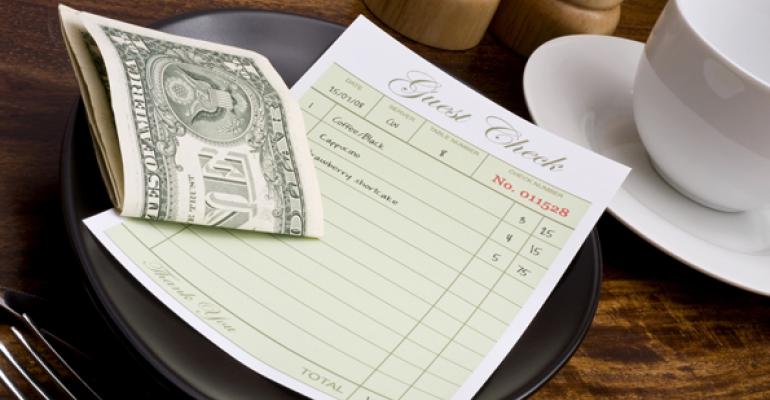A merry holiday season could be in store for the restaurant industry, as sales figures gain momentum heading into the end of the year and consumers’ budgets start to loosen.
The impact of higher incomes, lower gas prices and easier comparisons should offset concerns among operators about a potentially tepid holiday season.
“Sales finished strong in the third quarter,” said Wallace B. Doolin, chairman of TDn2K, parent of Black Box Intelligence, a monthly restaurant sales tracker. “I’m optimistic. We’re off to a good start in the fourth quarter already.”
Every major restaurant sales index rose in the third quarter. Black Box Intelligence, for instance, found that same-store sales rose 1.6 percent during the period and 2.2 percent in September. Similarly, the NRN-MillerPulse survey found a 2.7-percent increase in same-store sales in September. In both cases, third-quarter trends were the best in two years.
That momentum is carrying into October, and could yield a positive holiday season for the industry, which would be a needed shot in the arm after years of weak customer traffic.
The bar this year to have a good fourth quarter is not very high. Last year’s holiday shopping season was undone by a combination of bad weather and a late Thanksgiving. Traffic fell 4.5 percent in December 2013, according to Black Box.
In addition, the positive factors that could affect restaurant sales outnumber any potential negatives, said Larry Miller, cofounder of MillerPulse, which partners with NRN to publish the NRN-MillerPulse report on restaurant sales and traffic data. “At the margins, excluding any other factors, it looks like it’s going to be a decent (quarter),” he said.
The primary positive factor is income. Employers are adding jobs, and that’s finally starting to push incomes higher after years of stagnation. Disposable personal income increased 0.3 percent in August, according to federal data. That’s a key statistic that drives restaurant sales. The more disposable income a person has, the more likely they are to spend on dining out.
Another factor in operators’ favor: gas prices. According to AAA, gas prices average $3.04 nationally. That’s down 25 cents compared with this time a year ago. While it’s often thought that lower gas prices yield higher restaurant sales, because people have extra cash, it can also increase travel. That’s important during a high-travel season like the holidays.
“If you’re not home, you’re not cooking at home,” Miller said.
All of these factors should also help drive retail sales. Various forecasts are pointing to a modestly brighter picture for retail holiday shopping. The National Retail Federation says sales will increase 4.1 percent compared with the 2013 holiday season. The audit and consulting firm Deloitte is predicting a similar improvement, 4 percent to 4.5 percent for the holiday season compared with the same period last year.
In theory, more shopping should drive more restaurant sales, but a large percentage of that increase should come not in retail outlets but online, continuing a years-long trend that was especially pronounced last year. While retail sales grew 2.7 percent last year, retail foot traffic fell 14.6 percent, as more people stayed home and shopped online, according to ShopperTrak, a retail research company.
That decline in foot traffic was cited in the bankruptcies of two mall-heavy restaurant concepts earlier this year, Sbarro and Hot Dog on a Stick.
Deloitte predicted sales at Internet sites and mail order companies should grow 13.5 percent to 14 percent this year.
“If you do the math, there will be less sales in stores,” said Rod Sides, Deloitte Consulting retail and distribution practice leader. “Traffic will probably be down. We don’t know by how much.”
Some restaurant chains are already adjusting to a new reality in which they can’t quite count on holiday retail traffic the way they once could.
Starbucks, for instance, is giving away coffee for life. Calling the 2013 holiday season a “seismic shift in consumer behavior,” Starbucks CEO Howard Schultz rolled out a series of efforts to reshape the holidays at his chain.
The effort includes some new product offerings and promotions to encourage use of mobile payments. The company is introducing mobile order and payment in its Portland area units, and it has started a contest in which Starbucks card or mobile pay customers will be eligible to win free Starbucks for life.
The biggest wild card for the 2014 holiday season is weather. Last year, a couple of poorly timed winter storms near weekends during the holiday season kept a lot of people inside. How much retail foot traffic declines this year may depend on the weather too.
But weather predictions are even more difficult to parse. “I’ve looked at three different forecasts and none of them agree with each other,” Doolin said. “So who knows?”
Contact Jonathan Maze at [email protected].
Follow him on Twitter: @jonathanmaze

